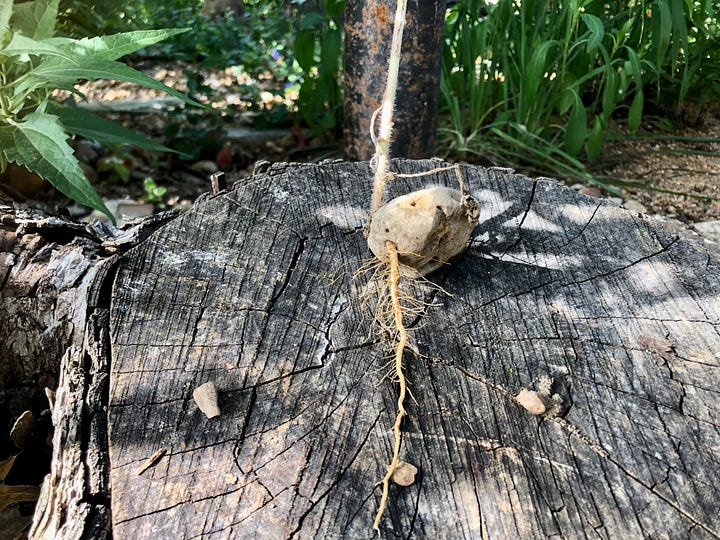Over the past few months I realized that I was forgetting to breathe deeply as I had learned not too long ago. Instead I found myself frequently holding my breath as if I could stop time or pain or negative things from happening.
Simple breathing exercises worked for me in the past. Exercises like naming the inhale and exhale or following the complete duration of each were helpful during sleepless nights or painful medical procedures. I had developed a routine whereby I turned to my breath whenever I had a free moment, especially when waiting. For many doctor visits they helped ease anxiety and pain.
I described basic breathwork in this article:
As my routines changed, my focus on deep breathing fell to the wayside. I was in the habit of meditating as I sat in waiting rooms. Now with fewer medical appointments—thank goodness—I no longer had a built-in opportunity to focus on deep breathing. I realized I was missing something. It was time to recharge my practice. I found a 14-day breathwork challenge in Insight Timer. While the app and many of the meditations are free, the Plus version contains more goodness, including the 14-day series I was intrigued by. I decided to splurge. Here are a few of my favorites.
Preparing
It can be helpful to set the table so to speak before launching into an exercise.
Inhale through your nose for a count of at least 4.
Sigh as you exhale through your mouth for a count of at least 4.
Repeat a few times.
Box Breathing
Inhale through your nose for a count of 4.
Pause and hold for a count of 4.
Exhale through your nose for a count of 4.
Pause and hold for a count of 4.
The silent counting helps to prevent my mind from wandering, and during the pauses between the inhalation and exhalation I notice stillness and calm. I try to repeat this cycle for 5 to 10 minutes. At the end of the session, I feel an interesting combination of ease and energy.
4-7-8 Breathing
Inhale through your nose for a count of 4.
Hold for a count of 7.
Exhale through your mouth for a count of 8.
Repeat this 4-7-8 set 4 times.
Next, pause and breathe normally for a few cycles. Try to focus on your breath and how your body feels. After the pause, complete another 4-7-8 breathing set 4 times.
This breath exercise was a bit challenging at first during the longer holds and exhales. Once I became accustomed to the sequence, I noticed how still the longer hold was and how easy it became to control my exhale. Everything slowed down as I was able to focus only on my breathing.
Bee Breath
Inhale through your nose for a count of 4.
Exhale through your nose for a count of 8.
Repeat a few times.
When you’ve finished the counting breaths, move on to the bee breaths.
Inhale through your nose for a count of 4.
Press your index fingers on the cartilage of each ear to close them.
Hum as you exhale through your nose for a count of 8.
Repeat 5 to 10 times.
At first, I found this exercise odd, especially since I’m afraid of being stung by bees! Then I noticed that the sound is very soothing and leaves me relaxed.
Breath of Fire
Inhale through your nose.
Without pausing, forcefully exhale through your nose.
Repeat for 30 seconds to one minute.
Take a break with three longer cleansing breaths.
Inhale through your nose for a count of at least 4.
Exhale through your mouth with a long sigh.
Repeat the sequence of these two exercises two or three times.
Breath of Fire is a more energetic breathing style. This technique requires more focus than the more relaxing breath exercises and as a result can help with developing and improving concentration. As a bonus, the forceful exhale is a mini workout for your abdominal muscles.
Standing Breaths
Prepare: Stand upright, hands by your sides, and close your eyes if you can. Inhale and exhale a few times.
Incorporate arm movement: Inhale through your nose as you raise your arms, palms facing up, until your hands meet above your head.
Exhale through your nose as your lower your arms, palms facing down, until your hands touch your sides.
Repeat this cycle of raising and lowering your arms as you inhale and exhale 3 or 4 times.
Incorporate side stretches: Inhale through your nose as you raise your arms above your head; clasp your hands and turn your palms outward.
Exhale and bend to the right.
Breathe into your left side a few times.
Raise your arms above your head.
Exhale and bend to the left.
Breathe into your right side a few times.
Return your hands to your sides.
Reflect: Stay standing with your eyes closed for a few breaths.
I enjoy this exercise as it combines breathing with simple, beneficial stretches, effectively connecting my breath with my body’s actions. You can also do this breathing exercise in a chair.
Unilateral Nostril Breathing
Use the fingers of your dominant hand to gently close your right or left nostril.
Inhale and exhale through the nostril 25-30 times.
Repeat with the other nostril.
This exercise has some interesting science behind it:
When performed consistently, unilateral left nostril breathing can reduce mind wandering.
Unilateral right nostril breathing confers immediate stress reduction and relaxation.
(H/T to Gloria for the link to the PubMed article.)
Consistency is Key
I know the value of consistent practice and yet fall off and then begin again. And again. Today I was clearing plants in the garden and uprooted this gem. Sometimes it feels like my life is like this wildflower, trying to grow and survive by pushing its root through a stone. And look how it found a way.


A few health anniversaries
This time of year brings up a lot of memories relating to my health odyssey. Here’s a quick roundup of late spring events during the last three years.
2022
June: Started immunotherapy for stage 4 metastatic melanoma, a surprise demon that burst onto the scene the previous December.
2023
May: Received my last immunotherapy infusion. My treatment plan had one more infusion in the hopper for June, but in late May I was diagnosed with ulcerative colitis after having endured months of debilitating symptoms. This autoimmune condition with no cure was unfortunately a result of the cancer treatment that likely saved my life.
June: Spent a hospital holiday receiving IV infusions of steroids to try to beat back the colitis. While in the hospital, my symptoms improved. After discharge, they all returned. I then turned to Remicaid, a different type of steroid that purports to be gut-specific.
July: Days after receiving the first IV infusion of Remicaid, a new demon arose seemingly out of the blue—this time bacteria—to attack my lower right leg. Because the bacteria is common, my system would have shrugged it off in happier times. This time, I likely succumbed due to the steroids that had weakened my immune system.
2024
June: This month (and most of 2024) I was living in limbo as the leg wound healing had stalled and the latest colitis treatment was not yet helping to improve symptoms.
2025
Here’s how things stand in late spring early summer 2025 on my three major health fronts:
☀️
The latest CT scan for the cancer was clear again, and I actually heard the oncologist use the word cured. As a result, I’ve graduated from scans every four months to scans every six.
🌤️
My leg is not back to the way it was, but the wound is covered with skin and I can walk.
🌦️
My GI health is the tricky and stubborn outlier. With my gastroenterologist, we are investigating three major areas: colon, small intestine, and stomach. While inflammation in my colon is back to normal (super good), I still do not feel well most days. I was taking a proton pump inhibitor (PPI) for potential acid reflux, but this drug did not allay my symptoms. I’m now testing DivertX, a combination of curcumin and coptis extracts that address inflammation in the small intestine. Another interesting intervention: three meals only per day with at least 4 or five hours separating them. This gives my migrating motor complex a chance to complete its cleaning phase and train my GI tract to operate more efficiently.
The field of investigation is vast, and I’m trying not to be too down about the whole project. I won’t lie, however: I’m definitely not perky everyday about what new test I might get to try next. I’d really just like to not think about food and eating ever again.






I love this stuff about breathing. I am always forgetting to breathe!! Seems kinda dumb because I die if I don’t breathe. I love the fact that you don’t like the thinking about food. I feel ya!